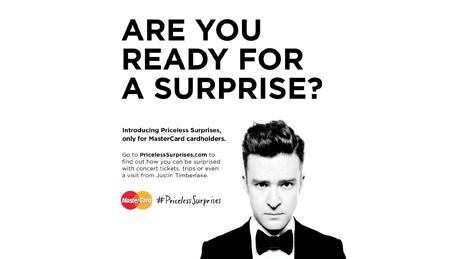Profile: MasterCard global CMO
Five months into the chief marketer job and Raja Rajamannar’s PricelessSurprises upgrade on MasterCard’s Priceless campaign is paying dividends – despite the Brits PR blip last week. But how will he fare tackling the rapid evolution of payment technologies, the surge in competition and the barriers to a ‘cashless society’?

MasterCard’s Raja Rajamannar is a firm believer in the element of surprise. The Indian global chief marketing officer, who joined the payment network five months ago, is responsible for rolling out Priceless Surprises, the latest phase of the brand’s long-running Priceless campaign. The idea is to leverage MasterCard’s many sponsorship assets, including the recently held Brit Awards ceremony, to surprise its cardholders with exclusive rewards and content.
Not all surprises are necessarily welcome, however. On the morning of the Brits last week (19 February), MasterCard was confronted with a surprise of its own when a number of unflattering media reports emerged about its PR tactics for the event[1]. Marketing Week was certainly surprised by the furore, having interviewed Rajamannar the previous day when all appeared calm at MasterCard HQ.
The reports focused on an email sent to Telegraph journalist Tim Walker by MasterCard’s PR agency House PR, in which he was offered entrance to the Brits on condition he tweeted a number of pre-prepared messages that promoted MasterCard and the #PricelessSurprises hashtag. Enraged by this apparent attempt to dictate terms, Walker sent the email to Press Gazette and the story was picked up by other news outlets, including Channel 4 News and The Guardian.
The Priceless Surprises campaign quickly became the subject of ridicule across Twitter. “Good press coverage is hard to bribe. For everything else there’s Mastercard #PricelessSurprises,” tweeted The Independent’s Felicity Morse, for example.
Rajamannar was unavailable for further comment beyond the statement released by MasterCard which distanced the brand from the actions of House PR. “Attendance at the Brits is not, nor has it ever been, a condition of coverage or endorsement,” the statement read. (This interview was arranged by House PR, though neither Brits tickets nor promotional tweets were exchanged in the process.)
This rather bizarre episode is a cautionary tale about the pitfalls of PR-journalist relations and the dangers facing all brands on social media. But it’s an embarrassment that MasterCard should brush off pretty quickly too. YouGov’s BrandIndex platform, which measures public sentiment towards brands, shows that while there was a slight fall in MasterCard’s index score on the day of the event, by the end of the week this had recovered to its pre-Brits level.
I was acutely aware that I was inheriting an iconic campaign and that I couldn’t mess around with it
MasterCard is a $3.2bn (£1.9bn) income brand and the world’s second-largest payment network behind Visa, so such resilience is to be expected. Rajamannar, who joined MasterCard from US healthcare firm WellPoint last September, is building on a long-established legacy of strong marketing and vibrant branding that began with the Priceless campaign 17 years ago.
Priceless and its tagline “For everything else there’s MasterCard” has been at the heart of the brand since it was developed in partnership with ad agency McCann Erickson in 1997. The campaign is still held up by marketing lecturers as a gold standard in brand differentiation that has sunk into the public consciousness.
Rajamannar was mindful of the need to preserve this inheritance when he joined the brand last year. “I was acutely aware that I was inheriting an iconic campaign and that I couldn’t mess around with it,” he says.
Instead he aims to “enhance” the campaign and “take it to the next level” with the new rewards platform Priceless Surprises. While MasterCard has always used Priceless as a vehicle for providing cardholder benefits, including discounts on certain purchases and exclusive offers, the brand is seeking to inject greater excitement into the campaign by engaging with consumers directly.
“There is something that people love about surprises,” suggests Rajamannar. “There is a thrill and memorability that affects you deeper than something that just happens by itself.”
In order to create these surprises, MasterCard is leveraging its various sponsorship assets across music and sport. The first incarnation of the campaign came last month when it teamed with brand ambassador Justin Timberlake on a series of activations. These ranged from sending free digital downloads of songs to MasterCard users to having Timberlake himself visit cardholders’ homes. One such visit was recorded and used in a TV advertisement during the Grammys in January, of which MasterCard is also a sponsor.

MasterCard’s Surprises strategy makes use of its partnerships, such as the Brits, which gave it access to artists such as Kylie Minogue (above)
Similar activations were conducted with Kylie Minogue, Pharrell Williams and Laura Mvula to coincide with the Brits. This is the 16th consecutive year that MasterCard has sponsored the awards and Rajamannar insists it is a worthwhile partnership. Indeed, figures show that this year’s Brits was the most tweeted about show in UK TV history, with 4.2 million tweets. However, TV viewing figures also show it attracted its lowest audience for a live broadcast of the show, with 4.6 million viewers.
Rajamannar says Priceless Surprises will continue to roll out over the year to cover MasterCard’s other sponsorship assets, including golf tournaments and the UEFA Champions League. The brand is also using more unusual ways to provide surprises: for Valentine’s Day it partnered with a skywriting company in the US so that cardholders could surprise their partners with special messages in the sky.
“The entire spectrum of surprises is there, which will allow us to engage with a vast number of our customers and delight them, surprise them and interact with them,” he says.
It would be fair to say that payment processing is not the sexiest of subjects – particularly as all providers essentially facilitate the same function. Indeed, many consumers simply accept the payment network provided to them through their bank. The new Priceless Surprises campaign is therefore indicative of MasterCard’s attempts to drive preference towards the brand to the extent that consumers request a MasterCard from their credit and debit card issuers, rather than simply accepting the default option.
MasterCard’s income rose 15 per cent last year, while earnings per share climbed 19 per cent, but Visa remains the bigger player by some distance, with income of $5bn. This week Visa also claimed top spot in the Superbrands business ranking, displacing Apple, while MasterCard was fourth. In addition to other big companies such as American Express and PayPal, MasterCard faces competition from emerging players such as Ripple Labs and MCX, putting it up not only against consumer apathy but also a growing number of rivals.
“If you look at payment networks purely as a function, it could be easily commoditised,” notes Rajamannar. “Our challenge is how to add value and differentiate ourselves from our competitors.”

Early indicators from Priceless Surprises suggest MasterCard is having some success in cementing this differentiation. The company reports that its Grammys campaign with Justin Timberlake achieved a share of voice on social media of 66 per cent within the payment network category.
According to Rajamannar, social media is a big target area for MasterCard. The brand aims to create a viral effect with its Surprises activations by encouraging cardholders to share particular rewards with their social media contacts.
“When we send a customer a surprise digital [music] download, we don’t send them one – we send four copies of the same song so they can pass it on and also surprise their friends and family,” he explains. “It’s about creating a social movement around the surprise.”
Beyond flashy promotions and sponsorship campaigns, MasterCard is fighting for customers with new technology services that aim to position the brand as the market leader in payment processing (see box, below). In order to forge new partnerships with the banks, branded loyalty schemes and merchants that adopt their services wholesale, all payment networks are seeking to develop the next big technology that will change the way people shop.
Last week, for example, MasterCard agreed a partnership with Weve, the joint venture between Vodafone, O2 and EE, to develop mobile contactless payments in the UK. MasterCard will offer technology and integration services to banks and financial institutions that want to be included in Weve’s payment platform as it is rolled out.
If you look at payment networks as a function, it is easily commoditised. Our challenge is how to add value and differentiate ourselves
Of course, there have been plenty of false dawns when it comes to smartphone payment technology. Mobile still accounts for a tiny fraction of total payments, so it’s not surprising that the reaction to the Weve partnership was relatively muted. MasterPass, the digital wallet service launched by MasterCard last year is currently present in just five countries across 30,000 merchants, but there are plans to roll it out to 14 more countries this year.
A large part of Rajamannar’s role as CMO is to present advice on MasterCard’s new technology launches by determining what is likely to work in the mass market. He argues that consumer adoption will gradually creep up if marketers can harness insights effectively and communicate the benefits of new services clearly.
“The change in consumer behaviour happens eventually if they see value in it,” he says. “The key thing is to understand what is intuitive to consumers, because it’s very difficult to create habits that are against intuition.
“The other point is that even if we have the best of the products, what’s the point if I can only use it in very limited areas? You need partners in order to have wider acceptance.”
This outlook shapes MasterCard’s approach to global expansion, which varies hugely depending on the country and its existing payment infrastructure. MasterCard is currently present in 210 countries around the world and continually monitors how different markets are developing to determine where the best opportunities lie.
Rajamannar explains that some of MasterCard’s most innovative projects are in emerging economies, where the lack of established payment systems enables the brand to “leapfrog” existing technology and experiment on a large scale. Last summer, for example, MasterCard partnered with the Nigerian government on a pilot scheme involving the roll-out of 13 million MasterCard-branded national identity smartcards.

MasterCard invited consumers to tweet their photos for its Priceless New Year campaign
The prepaid cards enable people to make electronic payments and provide a safe means for the government to transfer social security benefits and other payments to citizens. The scheme, described as “the broadest financial inclusion initiative” of its kind in Africa, is designed to help Nigerians who do not have bank accounts or access to formal financial services.
MasterCard has used such initiatives to promote the benefits of a ‘cashless society’, arguing that electronic payments ensure a much higher level of security and accountability and help to combat black markets.
The brand works with governments around the world to provide various centralised payment solutions and even stepped in to support the Greek and Italian administrations at the height of their recent financial crises. Rajamannar believes that while MasterCard’s cashless ideal remains a long way off, the role of cash will progressively decline.
“Today 15 per cent of all transactions [globally] happen electronically and 85 per cent are still cash,” he notes. “It’s hard to know at what pace but the proportion of cashless transactions will increase.”
Rajamannar has an extensive background in the electronics payment sector, having worked in the credit card business of Citigroup in various capacities over a stretch of 15 years. He was hired by the financial services group to launch its credit card business in the United Arab Emirates in 1994, rising to chief marketing officer of Citi Global Cards in New York (see CV, below).
The key to changing consumer behaviour is understanding what is intuitive to them
Prior to joining Citigroup, he gained marketing experience and training at Asian Paints, India’s largest paint manufacturer, and the Hindustan office of Unilever. He joined MasterCard last year following a stint in the US health sector that included roles at Humana and WellPoint. Now based in New York once more, he reports to MasterCard chief executive and fellow Indian Ajay Banga.
Rajamannar’s global experience in a variety of roles should serve him well at MasterCard, where he has responsibility for a marketing operation spanning more than 200 countries. While he travels frequently in order to visit its global outposts, he is a believer in empowering regional and local managers.
“Most of the decision-making has to happen at the levels that are closest to the consumer – not in an ivory tower thousands of miles away from the ground-level reality,” he says. “[The] global [team] has a significant role to play in terms of setting the framework, policies and priorities but most of the action should happen closest to the consumer.”
This localised focus will prove important as MasterCard rolls out its new marketing activations and services to more territories. The brand’s global investment in marketing rose by 8 per cent last year (an increase of $66m) and it rounded off 2013 with its largest social media campaign to date (#PricelessNewYear). Rajamannar’s appointment looks set to continue the brand’s growing momentum – barring the odd PR hiccup, that is.
CV: Raja Rajamannar

2013-present
Chief marketing officer, MasterCard
2012-2013
Chief transformation officer, WellPoint
2009-2012
Chief innovation and marketing officer, Humana
2008-2009
Chief marketing officer, Citi Global Cards
1999-2008
Various management roles within Citigroup and its subsidiaries
1994-1999
Marketing and sales director, Citibank Gulf
1988-1994
Regional sales head and senior product manager, Hindustan
Unilever
1985-1988
Senior product manager, Asian Paints
1983-1985
MBA, Indian Institute of Management, Bangalore
New payment technology
To coincide with Mobile World Congress in Barcelona this week, MasterCard is making plenty of noise about its new payment services. At the beginning of the week the company launched an in-app payments system via its MasterPass digital wallet. The service is intended to remove the need to store payment card details across numerous mobile apps.
Forbes Digital Commerce, Starbucks Australia and Shaw Theatres Singapore are among the first to use the technology. MasterCard notes that according to ABI Research, overall revenues from mobile applications, including in-app purchases, will reach $46bn (£27.6bn) by 2016, more than five times the $8.5bn earned in 2011.
On the same day, MasterCard announced a deal to buy C-SAM, a software firm that enables mobile payments in India, Japan and Mexico, among other countries. Last week MasterCard also agreed a partnership with Weve, the joint venture between Vodafone, O2 and EE, that it claims will “accelerate the development of the UK’s most comprehensive contactless mobile payments system”.
Rajamannar says that given the rapid evolution of payment technology, it is in MasterCard’s interest to explore multiple different partnerships. The company launched MasterCard Labs in 2010 to serve as a research and development hub and counts Google, Intel and Samsung among its many technology partners.
“There are multiple options to pursue and lots of permutations and combinations across the payment ecosystem, so you need to take your bets,” he says. “That doesn’t mean putting bets on everything – it means shortlisting the options by testing and using insights about the consumer.”
This week MasterCard released new research that claims consumer and merchant opinion is becoming more amenable to mobile payments. The company, which worked with Prime Research to track more than 13 million social media comments, found that 88 per cent of merchant comments about mobile payments were positive.
Rajamannar explains that as chief marketing officer, he has a vital role to play in ensuring that the brand’s technology launches gain traction among merchants and consumers. “Unless there is a critical mass of acceptance, it’s not going to work for the consumer,” he says.
References
- ^ PR tactics for the event (www.marketingweek.co.uk)









